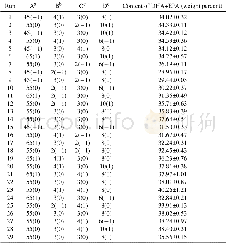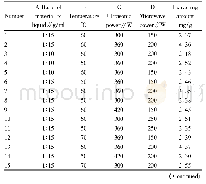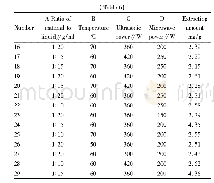《Table 2 Observed responses in the Box-Behnken design experiments》
 提示:宽带有限、当前游客访问压缩模式
提示:宽带有限、当前游客访问压缩模式
本系列图表出处文件名:随高清版一同展现
《Preparation of DHA-and EPA-enriched Glycerides by Enzymatic Interesterification Using Tuna Oil and Capric Acid》
Note:areaction temperature(oC);bsubstrate molar ratio(capric acid:tuna oil);cenzyme amount,based on the total substrate(%);dreaction time(h).
The glyceride composition of tuna oil used in this studycontained predominantly triacylglycerol.Neither diacylglycerol nor monoacylglycerol was detected.The fatty acid compositionand distribution of the tuna oil are shown in Table 3.The main fatty acids in tuna oil were DHA(22.22%),palm acid(19.26%),and oleic acid(14.67%).It is worth mentioning that the content of DHA+EPA in the tuna oil was 26.86%(22.22%DHA and4.64%EPA),which was close to the literature value[21].This result indicates that tuna oil could be used as a material for special products containing DHA and EPA.The tuna oil was rich in unsaturated fatty acids,representing up to 65.42%of the total fatty acid composition.The ratio of unsaturated to saturated(U/S)fatty acids detected in tuna oil was 1.89.The sn-2 position of tuna oil was occupied predominantly by DHA(39.10%),oleic acid(18.70%),and EPA(5.22%),and the unsaturated fatty acids in this position were 83.69%.The relevant contents of palm acid,stearic acid,oleic acid,linoleic acid,EPA and DHA in the sn-2 position of tuna oil were 17.15%,8.50%,42.49%,91.28%,37.51%,and 58.66%,respectively.The results show that in the main fatty acids of tuna oil,oleic acid,linoleic acid,EPA,and DHA are mainly located in sn-2 position whereas palm acid and stearic acid are mainly located in sn-1,3 positions.
| 图表编号 | XD0021321500 严禁用于非法目的 |
|---|---|
| 绘制时间 | 2018.04.30 |
| 作者 | LIANG Shaohua、WANG Mengyuan、ZHU Lijie、ZHANG Man、YANG Ming |
| 绘制单位 | School of Food Science and Technology, Henan University of Technology、School of Food Science and Technology, Henan University of Technology、School of Food Science and Technology, Henan University of Technology、School of Food Science and Technology, Henan |
| 更多格式 | 高清、无水印(增值服务) |





